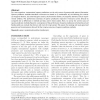Free Online Productivity Tools
i2Speak
i2Symbol
i2OCR
iTex2Img
iWeb2Print
iWeb2Shot
i2Type
iPdf2Split
iPdf2Merge
i2Bopomofo
i2Arabic
i2Style
i2Image
i2PDF
iLatex2Rtf
Sci2ools
BIB
2008
2008
The relative value of operon predictions
For most organisms, computational operon predictions are the only source of genome-wide operon information. Operon prediction methods described in literature are based on (a combination of) the following five criteria: (i) intergenic distance, (ii) conserved gene clusters, (iii) functional relation, (iv) sequence elements and (v) experimental evidence. The performance estimates of operon predictions reported in literature cannot directly be compared due to differences in methods and data used in these studies. Here, we survey the current status of operon prediction methods. Based on a comparison of the performance of operon predictions on Escherichia coli and Bacillus subtilis we conclude that there is still room for improvement. We expect that existing and newly generated genomics and transcriptomics data will further improve accuracy of operon prediction methods.
Related Content
| Added | 08 Dec 2010 |
| Updated | 08 Dec 2010 |
| Type | Journal |
| Year | 2008 |
| Where | BIB |
| Authors | Rutger W. W. Brouwer, Oscar P. Kuipers, Sacha A. F. T. van Hijum |
Comments (0)

